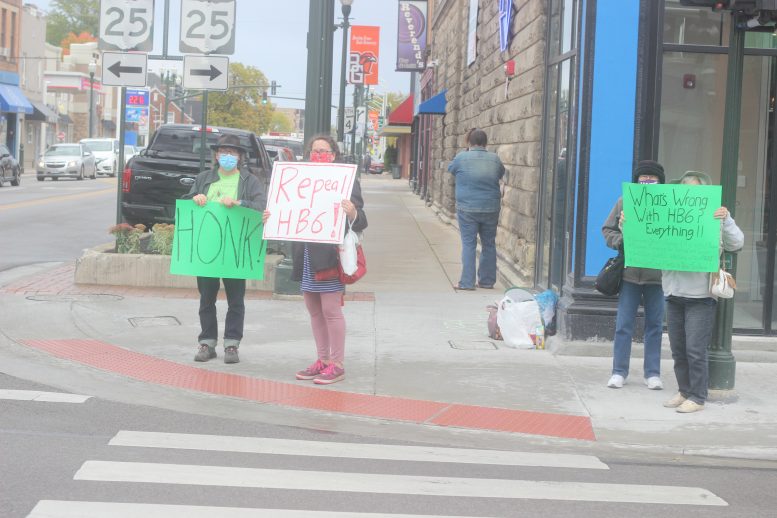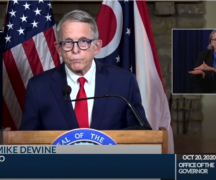Ohio state government continues to be gripped by an alleged $61 million bribery scandal involving a billion-dollar nuclear bailout.
But while the effort for that bailout was brewing as part Akron-based FirstEnergy’s strategy to prop up and spin off unprofitable nuclear power plants, another part of the strategy might have resulted in an additional — and potentially larger — bailout in a separate venue.
And, some observers warn, many more such bailouts throughout the country might be on the way.
In February, seven months after Gov. Mike Dewine signed the $1.3 billion ratepayer bailout that mostly would subsidize two Northern Ohio nuclear plants, FirstEnergy might have gotten an even bigger break in U.S. bankruptcy court. That’s when Judge Alan M. Koschik signed off on a settlement that largely excused FirstEnergy from footing part of the bill to clean up the aging nuclear plants in Ohio and another in Pennsylvania that it had bequeathed to to its successor, now known as Energy Harbor, in the event that company goes belly up.
If the new company can’t make a go of it with the nuclear and coal plants that had been owned by FirstEnergy, taxpayers could well be on the hook for whatever part of the estimated $10 billion nuclear cleanup that Energy Harbor and a trust fund it’s required to maintain can’t.
Those are cleanups that, for financial reasons, will take 60 years — decades during which the crumbling cooling tower of the company’s Davis-Besse plant, for example, will loom over the Lake Erie shoreline in view of South Bass Island, one of Ohio’s premier tourist attractions.
Energy Harbor’s “financial future doesn’t look bright and when we say (FirstEnergy) needs to set aside money for (shutting down and cleaning up the plants), their response is going to be, ‘The bankruptcy court approved the reorganization, FirstEnergy isn’t on the hook anymore,’” said Margrethe Kearney, senior staff attorney at the Environmental Law & Policy Center, which is appealing the bankruptcy ruling to the 6th U.S. Circuit Court of Appeals in Cincinnati. “This is a way that bankruptcy is increasingly being used by companies — to shed their environmental liability.”
And, Kearney said, companies across the country that own nuclear generators likely will try to use the bankruptcy to ease looming cleanup costs off of their books and onto the backs of taxpayers.
“Especially here in the Midwest we have a lot of nuclear power plants, a lot of them are coming to the end of their useful life, most of them are out of the money, so it doesn’t really make sense to invest in them because natural gas and renewable energy is less expensive and we’re going to have a real crisis when it comes to the decommissioning of power plants and the financial ability to pay for them,” she said.
A doozy of a scandal
The Ohio Capitol was rocked in July when the FBI arrested then-House Speaker Larry Householder and four associates in what U.S. Attorney David DeVillers said was “likely the largest bribery and money-laundering scheme ever in the state of Ohio.”
DeVillers alleged that $61 million flowed from FirstEnergy and related companies through 501(c)(4) dark money groups and into campaigns of House candidates who later elected Householder speaker, a perch from which he shepherded House Bill 6, the $1.3 billion bailout, to passage. (District 2 State Sen. Theresa Gavarone and District 3 State Rep. Haraz Ghanbari voted in favor of the bailout.)
The money also funded a nasty, xenophic campaign to block a voter initiative to repeal HB 6, while Householder and his associates simultaneously lined their own pockets with some of the loot, DeVillers said.
It wasn’t the only such scandal to break in July. In Illinois, Commonwealth Edison and parent company Exelon admitted to an eight-year bribery scheme targeting people around Illinois House Speaker Michael Madigan, who hasn’t been charged. One of the things the company received from the legislature during that period was a $2.35 billion bailout of two struggling nuclear power plants in that state.
In Ohio, nobody from FirstEnergy has been charged. But DeVillers in July said his investigation was far from over.
In September, Ohio Attorney General Dave Yost named FirstEnergy and associated companies as defendants in a civil suit. Among other things, it demanded that bailout funds be blocked and that the companies that funded the HB 6 scheme either fire the officials involved or see the companies themselves dissolved.
Who was in charge?
The funds promised by HB 6 were far from the first ratepayer largesse enjoyed by companies related to FirstEnergy, whose name graces the stadium in which the Cleveland Browns play. Last year, Ohio Rep. Mark Romanchuk, R-Ontario, said the company’s Ohio nuclear plants had received $10.2 billion in state subsidies since 1999.
The attorney general’s lawsuit says that four years ago, what to do about the failing nuclear plants was at the heart of what he said was a corrupt scheme to obtain a bailout.
“In late 2016, FirstEnergy Corp. had a problem,” the suit says. “The nuclear power generation plants it owned through its subsidiary FirstEnergy Solutions Corp. had turned from assets to liabilities.”
It also said that by spinning off the plants, passing the bailout and sending its former subsidiary through bankruptcy, FirstEnergy did lasting harm to the state. That’s because, the suit said, FirstEnergy had potentially shifted some of the burden to clean up the Perry and Davis-Besse reactors in Ohio from itself and onto the taxpayers.
“Ohio’s environmental future has been damaged, because the costs for the ultimate decommissioning of the nuclear plants are now secured by Energy Harbor, a company with far smaller capitalization than FirstEnergy Corp.,” the suit said. “To the extent that decommissioning and environmental repair costs exceed Energy Harbor’s ability to pay, those costs will be borne by Ohio through its ratepayers or taxpayers — a scenario that already played out once in the FirstEnergy Solutions’ bankruptcy plan that created Energy Harbor.”
Yet FirstEnergy maintains that after 2016 its leaders had no control over the former subsidiary that owns nuclear as well as coal plants in Ohio and Pennsylvania.
“FirstEnergy leadership has not had any decision-making power regarding the strategic direction of FES since November 2016, and FirstEnergy and Energy Harbor are now separate, unaffiliated companies,” FirstEnergy spokeswoman Jennifer Young said in September after the Ohio attorney general’s lawsuit was filed.
However, that claim seems hard to credit because FirstEnergy CEO Chuck Jones is also CEO of FirstEnergy Services.
Until June, First Energy Services provided the power plant-owning company that became Energy Harbor with many — if not all — of the services one would associate with running it. They include “administrative, management, financial, compliance, ethical, external affairs, and political and regulatory advocacy services. ”
For her part, Young said that the companies are independent because they have separate boards.
Long-term strategy
In late 2016, as FirstEnergy was spinning off the company that after bankruptcy became Energy Harbor, Jones announced a strategy of seeking a bailout for the spun-off company’s failing nuclear assets.
“We are advocating for Ohio’s support for its two nuclear plants, even though the likely outcome is that FirstEnergy won’t be the long-term owner of these assets,” Jones said.
In an affidavit supporting criminal charges against the former Ohio speaker and others, FBI Special Agent Blane Wetzel introduces the case for a criminal conspiracy by referring back to that time.
“In 2016, (FirstEnergy) Corp.’s nuclear generation future looked grim,” it said. “In its November 2016 annual report to shareholders, Ohio-based (FirstEnergy) Corp. and its affiliates reported a weak energy market, poor forecast demands, and hundreds of millions of dollars in losses, particularly from its nuclear energy affiliate…
“Given this backdrop, (FirstEnergy) announced future options for its generation portfolio as follows: ‘legislative and regulatory solutions for generation assets’; asset sales and plant deactivations; restructuring debt; and/or seeking protection under U.S. bankruptcy laws for its affiliates involved in nuclear generation.”
On March 31, 2018, Energy Harbor predecessor FirstEnergy Solutions exercised one of those options when it filed for Chapter 11 protection in the U.S. Bankruptcy Court of the Northern District of Ohio.
Broad immunity
By the time FirstEnergy Solutions emerged from bankruptcy in February, it had a new name, Energy Harbor, and it had largely released its former parent company, FirstEnergy Corp., from any responsibility to clean up the nuclear plants it used to own.
“It makes it really difficult to get into the pockets of the parent if the subsidiary runs out of money,” Kearney, of the Environmental Law and Policy Center said of the settlement.
In fact, the release worked out between FirstEnergy, a primary creditor, and its former subsidiary was so broad that Judge Koschik disallowed part of it, saying it would make the overall settlement legally unconfirmable.
“The only (nuclear cleanup) ‘mechanism’ offered by (Energy Harbor) is its own assumption of these long-term environmental obligations and a promise that as a reorganized debtor with new capital structure facilitated by (FirstEnergy Corp.), it will stalwartly stand by and satisfy these claims if and when they arise,” Koschik wrote.
FirstEnergy and its former subsidiary modified the “third-party releases” and Koschik signed off on the overall settlement.
But he did so without allowing Kearney’s group to put on testimony from an expert witness, Peter Bradford, a former commissioner with the U.S. Nuclear Regulatory Commission. Bradford planned to testify that there were expenses far in excess of what the commission — which is responsible only for the cleanup of radioactive material — requires nuclear operators to pay into a trust fund, Kearney said.
Koschik’s refusal to hear from Bradford is a big part of why the Environmental Law and Policy Center and associated groups are appealing the bankruptcy settlement, although they also have briefed the appellate court on the federal criminal and state civil actions surrounding the HB 6 bailout scandal.
“We are asking to have our expert heard on the nuclear decommissioning issues,” Kearney said. “That doesn’t mean that the entirety of the bankruptcy proceeding will be reopened.”
Cleanup of the century
Asked last week about what it would cost to clean up its former nuclear plants in Ohio and Pennsylvania, FirstEnergy’s Young said, “FirstEnergy’s liabilities related to nuclear decommissioning are hypothetical and comparable to any former owner of nuclear generating facilities. The bankruptcy did not change that. The other questions you asked about decommissioning would need to be directed to Energy Harbor since they are the current owners and operators of the plants and are primarily liable for decommissioning. As you’ll recall, Energy Harbor is a separate company now unaffiliated with FirstEnergy.”
Calls and emails to two Energy Harbor spokesmen were unanswered.
Young said that as of June, Energy Harbor’s nuclear decommissioning trust funds were worth about $2 billion.
The cleanup envisioned for Perry and Davis-Besse plants in Ohio and the two Beaver Valley units in Pennsylvania would extend for the better part of a century — from 2021 through 2083, according to 2018 studies performed for FirstEnergy as part of the bankruptcy. Kearney said the longevity of the process isn’t because the cleanup is so complex. It’s because the money in the trust fund isn’t enough to pay for it now, so it needs time to grow.
However, based on the estimates commissioned by FirstEnergy, it’s hard so see how $2 billion would be enough. They list four categories of costs associated with the cleanup:
- Decommissioning, including a 17% contingency
- Hefty NRC license-termination fees (fees are a major source of the agency’s funding)
- Spent-fuel management
- Non-nuclear demolition
Taken together, the combined estimated cost to shut down and clean up all the facilities is $9.6 billion in 2014 dollars. And not nearly all of the $2 billion in the trust fund will be allowed to grow until 2074 to meet it.
The total cost to clean up Beaver Valley Unit 2, for example, is estimated at just under $2 billion, or about 20% of the total.
The timeline in the estimate calls for about an eighth of that — $233 million — to be spent through 2026 preparing for a 48-year “dormancy” period. The estimate says that it will cost between $6 million and $7 million a year for the first 33 years and $3 million to $4 million a year for the next 15.
In other words, if Energy Harbor were to stop paying into the trust fund tomorrow, far less than $2 billion will be allowed to grow until the final cleanup starts in 2075.
The estimates were financed by an interested party, FirstEnergy. But even if they weren’t, Kearney stressed that they could be significantly off — especially since they’re drawn out over such a long period. She said, however, “That $2 billion represents about half of the (overall) estimated cleanup costs.”
The uncertainty over how much the nuclear cleanups will cost and whether Energy Harbor can pay for them makes it unjust that its bankruptcy let FirstEnergy off the hook — especially in light of the criminality alleged in Ohio’s other nuclear bailout, the state’s official consumer representative said.
“An inadequate funding of the future decommissioning costs for the Davis-Besse and Perry nuclear power plants would also be of concern to Ohioans who, one way or another, may ultimately be asked to pay the tab for any shortfall in funding of these costs,” the Office of the Ohio Consumer Counsel said in a brief filed with the 6th Circuit. “Such a result would be objectionable for consumers.”
The OCC needn’t have limited his claims to the potential burden to Ohioans. As things stand now, if Energy Harbor can’t cover the cost of the cleanup, it will fall on all U.S. taxpayers.
***
2020 Census counting wraps up in Ohio
That’s a wrap on counting people for the 2020 U.S. Census.
Data collection ended last Thursday, with that being the last day for field workers to finish their household visits and the last day for people to submit their own Census responses.
The final day had been moved several times. The Trump administration had sought to end counting in order to reach a year-end deadline for reporting the results in order to determine the new apportionment of seats in Congress. Others had pushed to keep counting, with fears that the pandemic would lead to vulnerable and minority populations being undercounted.
In the end, the U.S. Census Bureau reports that 70.6% of all Ohio housing units self-responded to the census (by phone, mail or online). Field workers spent months conducting “nonresponse followup” to get nearly all of the remaining units counted. READ MORE
DeWine endorsements highlighted in suburban legislative districts
Though Gov. Mike DeWine remains controversial among some Republican state legislators, the political party is still highlighting endorsements from Ohio’s top executive in select races, including Haraz Ghanbari (R-Perrysburg).
DeWine has faced an onslaught of criticism and legislative rebuke from the Ohio Statehouse related to his year-long response to the coronavirus pandemic. Much of the backlash has come from members of his own party.
A growing number of bills, all of them Republican-led, have sought to curb the power of the executive branch in responding to such a crisis. Four Republican members have called for the governor’s impeachment and one of them wantsDeWine to face criminal charges.
But DeWine remains popular among the general public, which has given the governor favorable marks throughout 2020 for his handling of the pandemic.
The Ohio Republican Party has purchased Facebook advertisements this month highlighting DeWine’s endorsement in seven legislative contests, most of them in suburban areas. READ MORE





